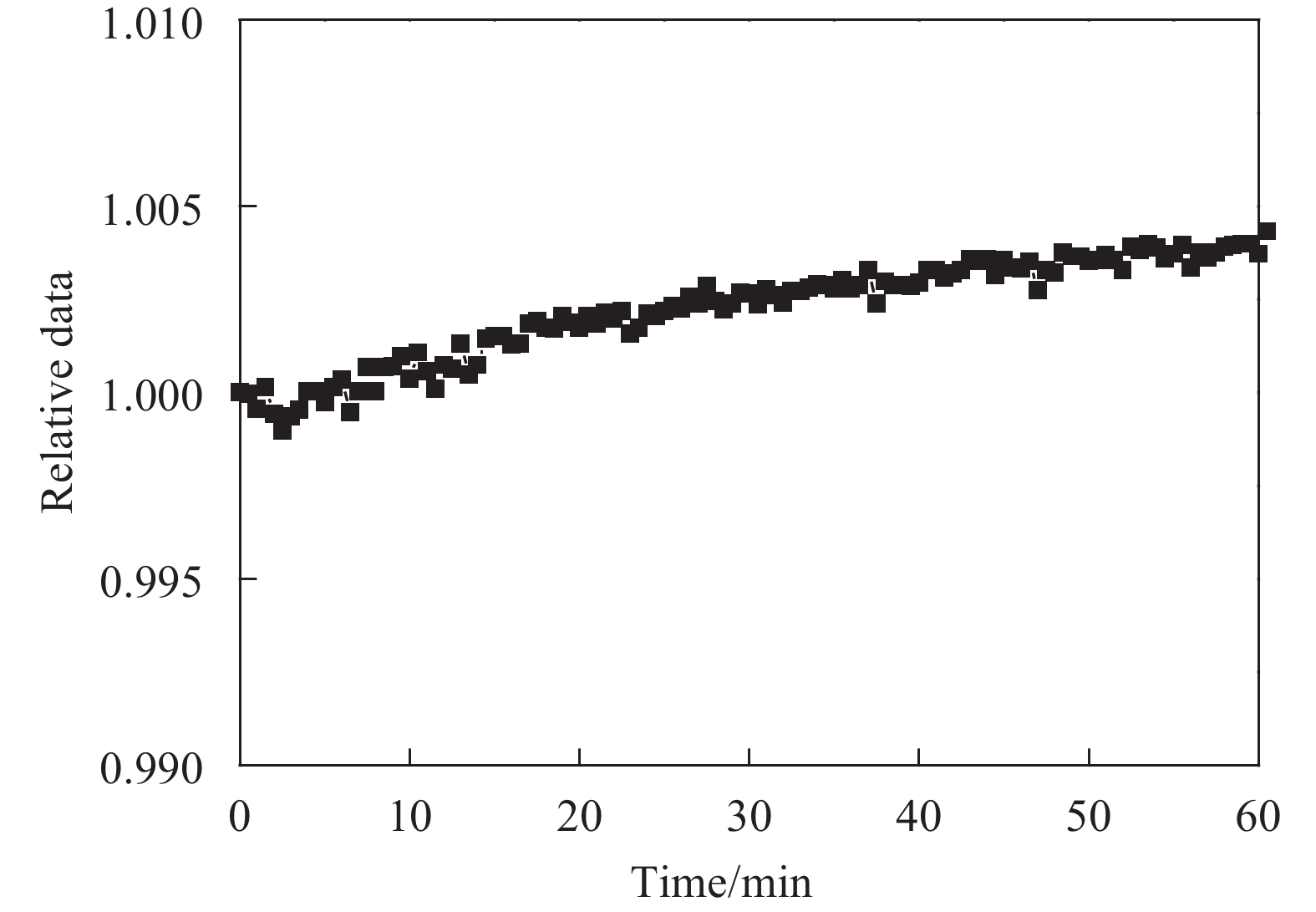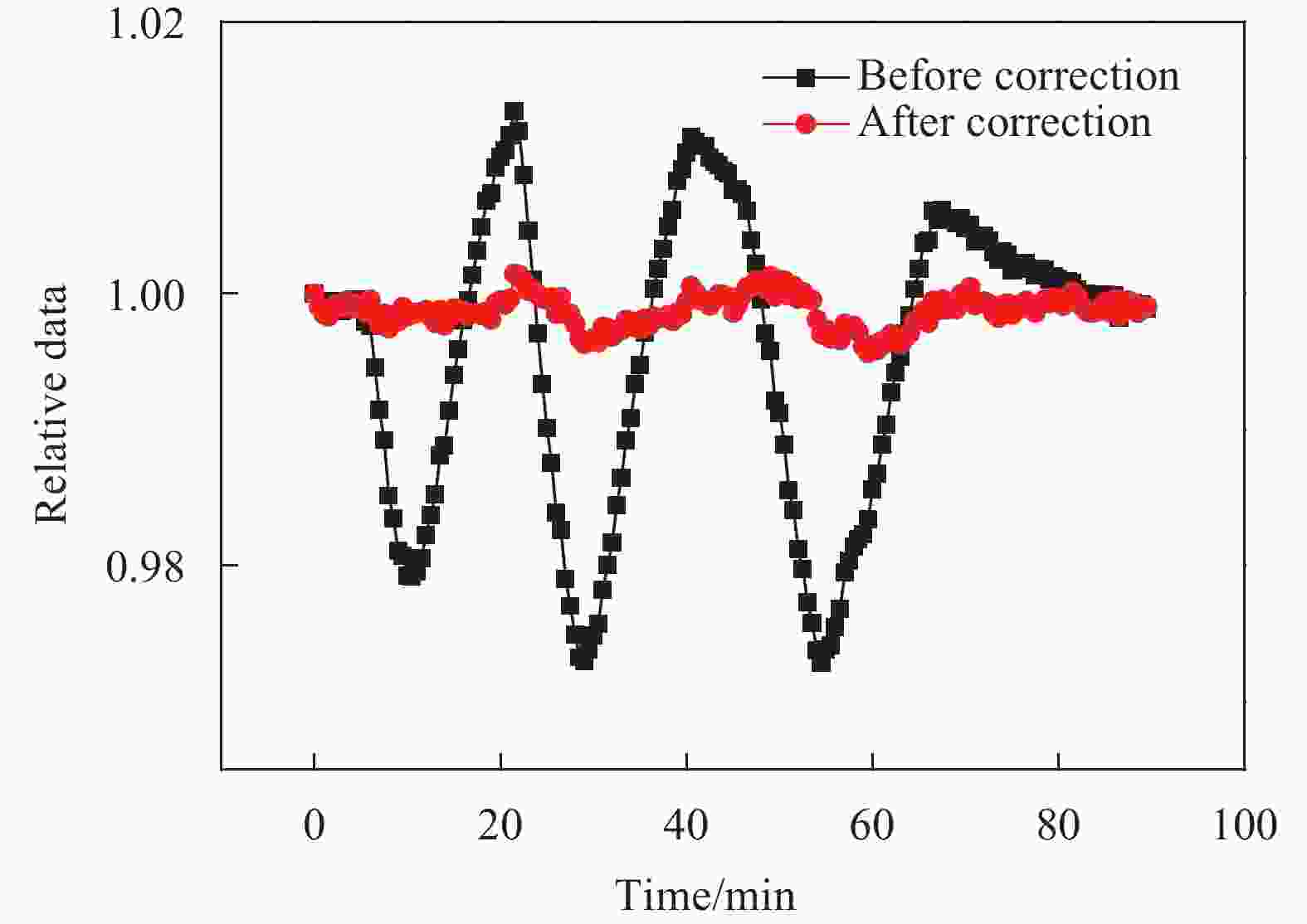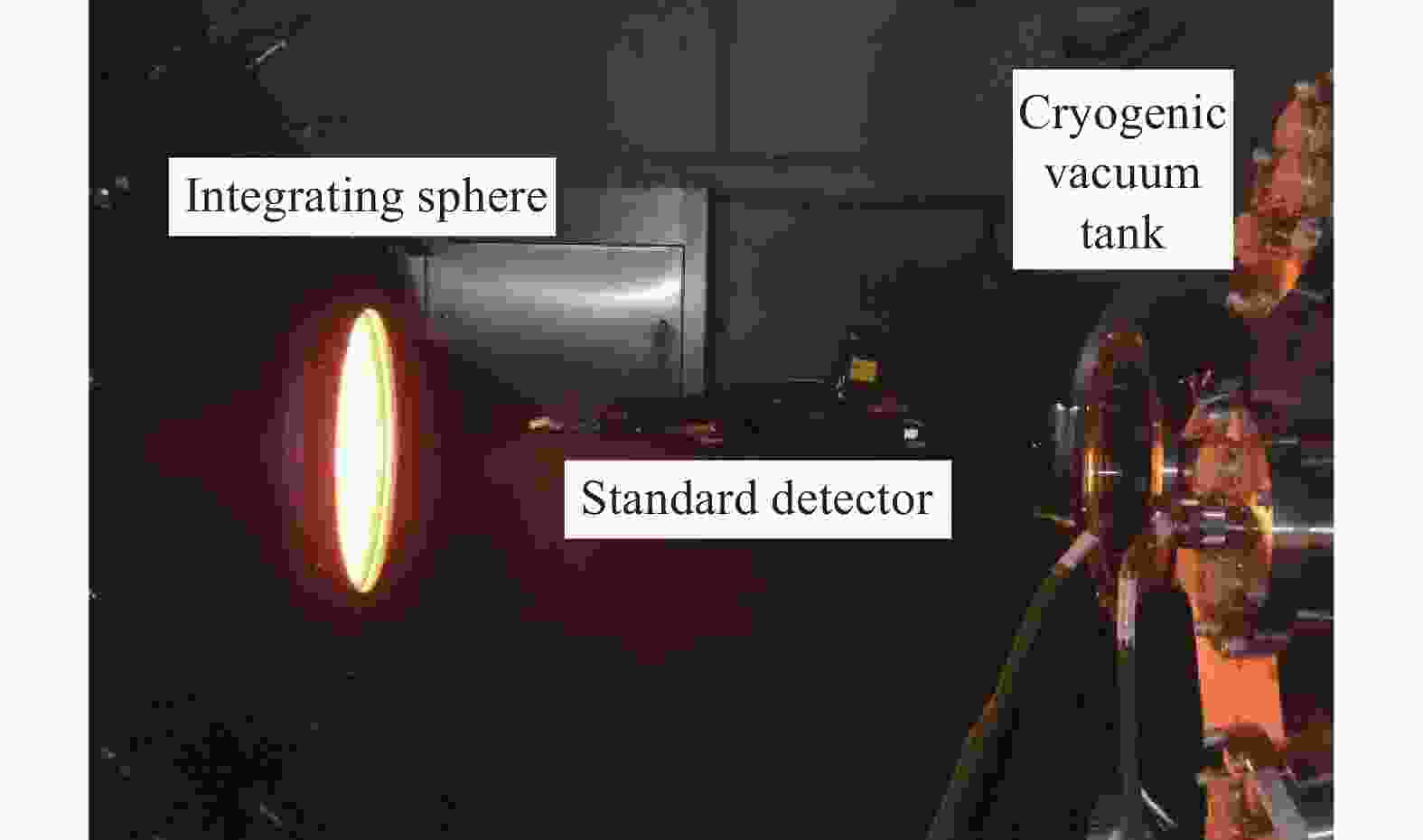-
卫星遥感的发展使得人类能够以新的视角去认知地球,遥感信息的定量化是其必然趋势。星载相机对地表信息的观测数据混杂着大气信息,面对遥感图像分辨率的提高和大气环境污染的矛盾,如何消除大气对卫星遥感图像的影响,是遥感数据定量应用的关键问题之一。基于实测大气参数和辐射传输模型的大气校正是该领域的研究热点,而大气情况随时间和空间变化剧烈,通过在同平台搭载专用仪器,获取与星载相机图像同时刻和同区域的高精度大气参数,逐渐成为大气校正的重要措施和环节[1-2],典型的仪器主要为国外EO-1卫星搭载的LEISA Atmospheric Corrector ( LAC)以及WorldView-3 卫星Clouds,Aerosols, Water Vapor, Ice and Snow (CAVIS) [1],国内为双角度偏振大气校正仪航空样机[3]。
2020年7月发射入轨的高分辨率多模综合成像卫星,是我国首颗分辨率跨入亚米级的民用光学遥感卫星,该平台搭载了中国科学院安徽光学精密机械研究所研制的大气同步校正仪(Synchronous Monitoring Atmospheric Corrector, SMAC)作为业务载荷之一,用于主相机高分辨率遥感图像的大气校正。SMAC设置了覆盖可见、短波红外波段的8个波段,获取的目标辐射、偏振信息可用于:(1)反演关键的大气参数,包括气溶胶参数、水汽柱含量等;(2)云识别,区分云像元和晴空像元,去除云对大气参数反演精度的影响。其中,云识别对象包括中低云和高层卷云,中低云通过复用大气参数探测波段所测反射率进行识别,而该方法对高层卷云不适用。卷云位于大气中的大部分水汽之上,由冰晶粒子构成,对太阳辐射有较强的散射作用。SMAC设置了对水汽有强吸收作用的1380 nm波段(带宽40 nm),专门用于卷云的识别。天空中无卷云时,大气中的水汽将该波段能量几乎全部吸收,1380 nm波段观测信号几乎为0;天空中存在卷云时,“遮住”下方水汽,卷云对太阳的强散射作用会使1380 nm波段能量升高,1380 nm波段观测信号增大[4-8]。
为保证大气参数反演精度,要求SMAC卷云识别波段的实验室绝对辐射定标不确定度优于6%,稳定性误差作为其重要不确定度来源需控制在1%以内。国内FY-2 B星载扫描辐射计水汽通道为6.3~7.6 μm,其定标在真空罐内进行,采用自身星上黑体作为定标源,不受水汽影响[9];美国中分辨率成像光谱仪(Moderate Resolution Imaging Spectroradiometer,MODIS)定标采用积分球光源,研究人员指出不同湿度环境对水汽吸收波段能量的影响可达25%[10]。考虑SMAC卷云识别波段的水汽强吸收特性,理想情况下其稳定性测试应该设置在干燥无水汽干扰的环境下完成。但由于实验室测试条件限制,无论是增设真空罐内可用的均匀面光源,或为测试系统营造专用的无水汽环境,都将大大提高时间、经济成本。SMAC卷云识别波段辐射定标源为积分球,位于真空罐外,水汽强吸收特性使SMAC卷云识别波段极易受到辐射传输路径上水汽含量波动的影响,如何控制或消除稳定性测试期间水汽对卷云识别波段的辐射吸收效应,是有效评估SMAC卷云识别波段稳定性误差的关键问题之一。文中对SMAC卷云识别波段稳定性测试影响因素进行分析,并对各项影响因素进行控制和消除,最后对测试结果进行分析讨论。
-
SMAC稳定性测试光源选用内置卤钨灯的积分球光源,即卤钨灯产生的辐射能量经过积分球内壁的匀光涂层多次漫反射后,形成的均匀面光源。测试原理图如图1所示,因红外探测器的制冷对工作温度有较高要求,故将SMAC放置于真空低温设备内,令其通过光学窗口观测光源,在一定时间内保持光源、SMAC状态不变,采集SMAC观测数据并评价数据稳定性误差。
Instrument Main characteristics Integrating sphere Sphere diameter: 1200 mm
Exit port diameter: 400 mm
Light source/number: Tungsten halogen lamp/16Cryogenic vacuum tank Temperature control range: −175 to 100 ℃
Temperature control accuracy: ± 2 ℃
Vacuum degree: 10−3 Pa to normal pressureStandard detector Stability error:0.4%@1380 nm Table 1. Information of instruments for stability test
卤钨灯积分球光源预热稳定后,SMAC对光源进行1 h的持续观测。以0.5 min为间隔统计SMAC数据的最值、均值,计算稳定性误差,表达式为:
式中:
$ {E_{stability}} $ 为SMAC稳定性误差;$ {d_{\max }} $ 、$ {d_{\min }} $ 、$ {d_{average}} $ 分别为SMAC稳定性观测数据最大值、最小值、均值。SMAC卷云识别波段(1380 nm)的稳定性测试曲线(见图3)呈现周期性的、较大幅度的波动,稳定性误差高达4.08%。SMAC卷云识别波段数据的波动,可能来源于以下两个方面:(1)卤钨灯光源自身的稳定性误差;(2)水汽波动影响,即卤钨灯至真空低温设备光学窗口的辐射传输路径上,水汽含量的波动使其对1380 nm波段辐射能量的吸收程度出现波动,进而使SMAC卷云识别波段接受到的能量出现波动。
其中,卤钨灯光源稳定性与电源供电稳定性有关,表现为当电流波动时,光源辐射光谱随之整体上升或下降。SMAC的870 nm通道为窗区通道,即不受传输路径上水汽波动影响,其同时段观测数据能够直观地反映光源稳定性。由图3可以看出,870 nm通道观测数据较为平稳,稳定性误差仅0.37%,表明卤钨灯输出稳定,卷云识别波段的大幅度周期性波动与卤钨灯稳定性无关。
另一方面,辐射传输路径上的水汽对1380 nm波段的辐射存在强吸收,空气中水汽含量的变化直接影响SMAC所接收到的辐射量,而周期性的波动与洁净实验室内的空气循环有关。为此,可采取以下两个措施排除水汽波动对测试数据的干扰:(1)控制辐射传输路径上的水汽波动幅度,在根源上抑制其对1380 nm波段辐射的干扰作用;(2)设置同波段标准探测器,对1380 nm处的辐射水平进行同步监测,间接校正水汽波动影响。
-
辐射传输路径包括两部分:(1)积分球内多次漫反射路径;(2)积分球口至真空低温设备光学窗口路径。
假设水汽浓度不变,那么辐射传输路径越长,水汽对1380 nm波段辐射能量的吸收就越强。卤钨灯光线在积分球内壁经过多次漫反射后到达球口,实际辐射传输路径的长度远大于积分球半径。积分球半径为0.6 m,球心对球口张角为±18.4°,积分球内涂层反射率大于0.95,根据Platnick等人采用蒙特卡洛方法运算的平均传输路径长度[9],卤钨灯发出的光到达球口的传输路径长度约为10 m,而球口至真空低温舱光学窗口距离仅为1 m,若积分球内、外水汽浓度相同,积分球内水汽的波动则为图3曲线大幅波动的主要原因。为此,对积分球设置密封光学窗口并进行氮气冲洗,使积分球内保持1个大气压左右的高纯氮气环境,排除球内水汽波动因素对SMAC卷云识别波段稳定性测试数据的影响,结果如图4所示。

Figure 4. Stability measurement curve of cirrus cloud diagnosing band for SMAC after water vapor isolated in integrating sphere
SMAC卷云识别波段稳定性误差降低至2.00%,可以看出,观测强度值波动幅度虽有一定程度减小,但仍存在明显的周期性波动,而球内已充满高纯氮气,排除球内水汽干扰对测试数据波动的改善效果并不理想。经分析,积分球内置卤钨灯点亮可产生较高的热量,球内温度可达50 ℃左右,对积分球内空气有一定烘干作用,并且腔体相对较封闭,使得球内水汽湿度与室内相比略低,且两处水汽波动情况并不一致。因此,残余波动来源于积分球窗口到真空低温舱光学窗口的路径上水汽对辐射的吸收作用。
实验室内水汽的波动与空气循环有关,在积分球内充满高纯氮气的基础上,关闭实验室空气循环设备,待空气中水汽含量逐渐稳定后进行SMAC卷云识别波段的稳定性数据采集,由图5可以看出,周期性的数据波动得到明显消除,曲线较为平稳,稳定性误差大大降低,仅为0.53%,与窗口通道(870 nm)稳定性误差水平相当,该结果表明SMAC卷云识别波段稳定性测试数据的周期性波动与实验室内空气循环导致的水汽含量波动有直接关系。

Figure 5. Stability measurement curve of cirrus cloud diagnosing band for SMAC after water vapor subsection control
为验证上述结论,拆除积分球光学玻璃使实验室空气进入,关闭实验室空气循环设备并适当增加稳定时间,进一步进行SMAC卷云识别波段的稳定性测试,结果如图6所示,SMAC卷云识别波段的稳定性误差降至0.23%,由此可见,积分球内空间无需进行氮气冲洗,实验室内水汽波动的控制就是提高SMAC卷云识别波段稳定性评估真实性的有效措施之一,同时也可节约测试时间和经济成本。
-
在真空低温设备的光学窗口附近设置同波段(1380 nm)标准探测器,卤钨灯到SMAC与标准探测器的辐射传输路径基本一致,水汽波动对辐射能量的吸收强弱变化将同时反映在两者观测数据上,如图7所示。
那么,利用同波段标准探测器监测数据的变化趋势,即可对SMAC卷云识别波段稳定性测试数据进行水汽波动影响的修正,表达式为:
式中:
$ {d_{corrected,t}} $ 为SMAC卷云识别波段t时刻观测数据$ {d_t} $ 经过水汽波动影响校正后的数值;$ {C_t} $ 、$ {C_{{t_0}}} $ 分别为t时刻及初始t0时刻同波段标准探测器的观测数据,而$ {C_t}/{C_{{t_0}}} $ 即为水汽波动影响的归一化修正系数。采用探测器同步监测数据对SMAC卷云识别波段观测数据进行修正,观测数据修正前后对比如图8所示,可以看出,曲线经过修正,稳定性误差由原4.08%下降为0.58%,经过修正SMAC卷云识别波段的稳定性误差水平与窗口通道(870 nm)相当,表明探测器同步监测修正是提高SMAC卷云识别波段稳定性评估真实性的另一有效措施。

Figure 8. Stability measurement data of SMAC’s channel for cirrus cloud detection before and after correction
图8经过修正的稳定性曲线带有一定的残留波动,经分析与图7所示两测量曲线存在小量的时间错位及幅值差异有关,主要受以下几点因素影响:(1)辐射传输路径存差异,标准探测器与SMAC对测试光源的观测角度、位置均不同(角度差异约30°);(2)带宽差异,标准探测器带宽为8 nm@1380 nm,与SMAC(40 nm@1380 nm)存在一定差异;(3)时间差异,标准探测器与SMAC测量因人为操作而存在一定时间差异(小于1 min)。
-
文中采取实验室水汽波动抑制和监视探测器同步数据修正等方法,降低实验室水汽波动对SMAC卷云识别波段稳定性测试数据的影响。测试结果表明:降低辐射传输路径水汽波动,SMAC卷云识别波段稳定性误差由4.08%降低至0.23%;采用同波段标准探测器的同步监视数据进行SMAC卷云识别波段数据修正,SMAC该波段稳定性误差降至0.58%水平。这两种方式均能够有效排除实验室环境水汽波动对测试数据的影响,对后续同类产品水汽强吸收波段的稳定性测试具有重要的参考价值。
Stability measurement method of cirrus cloud diagnosing band for synchronous monitoring atmospheric corrector
doi: 10.3788/IRLA20210647
- Received Date: 2021-12-20
- Rev Recd Date: 2022-01-20
- Publish Date: 2022-07-05
-
Key words:
- remote sensing /
- atmospheric correction /
- stability measurement /
- water vapor absorption band
Abstract: Synchronous Monitoring Atmospheric Corrector (SMAC), a support for the main camera, was one of the mayor facilities of high resolution and multi-mode imaging satellite. SMAC was designed to achieve atmospheric correction for high spatial resolution images based on radiative transfer model by getting synchronous parameters of aerosols and water vapor. SMAC had a special channel, where the radiance could be mostly absorbed by water vapor, for remote sensing of cirrus cloud. This channel was sensitive to the fluctuation of water vapor in the lab while stability measurement, thus the real performance of this channel could be covered up. The influence of water vapor fluctuation on stability test data was suppressed by controlling water vapor and setting synchronous monitoring detector. The results show that the stability error of SMAC’s channel for cirrus cloud detection decreased from 4.08% to 0.23%. It indicates that the stability measurement method of cirrus cloud diagnosing band for SMAC is reasonable and effective, which could reflect the stability performance of the product, and has important guidance significance for stability measurement of similar instruments.
























 DownLoad:
DownLoad:






